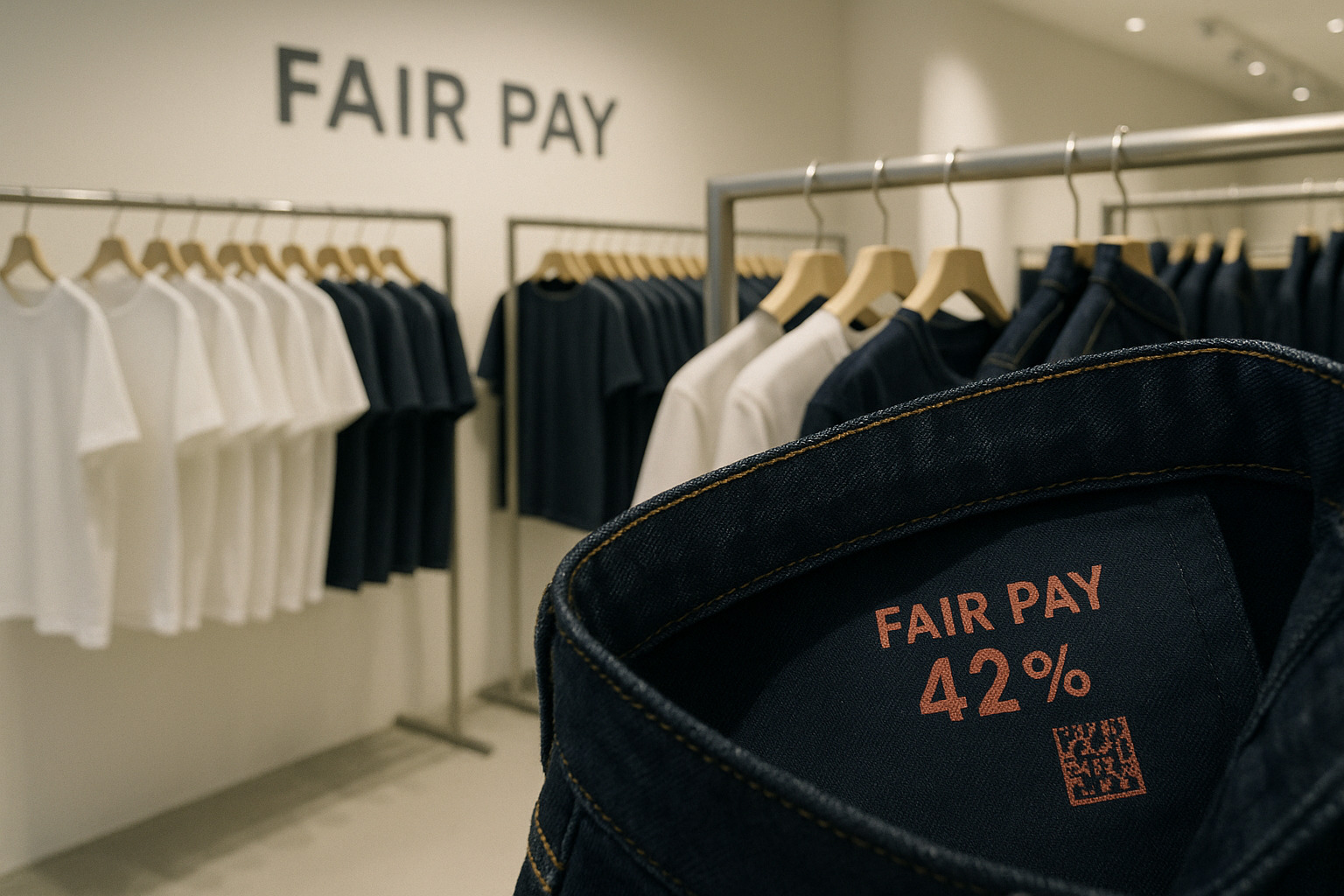Project related to the Master in Management and Direction of Fashion Companies, Barcelona
My Prompt
Text Prompt: Imagine picking up a T-shirt and seeing “Fair Pay 45 %” stamped next to the size, showing exactly what share of the retail price reaches the farmers, spinners, and sewers. We partner with certified factories to collect real wage data and map every cost from raw cotton through retail. Using (Total wages ÷ Retail price) × 100, we set a minimum 40 % Fair Pay. A custom heat-stamp die and eco-friendly ink are prototyped on denim and jersey and tested over 30 wash cycles. A pilot capsule of 50 T-shirts and 50 jeans, each stamped with its real Fair Pay percentage, will launch. Submit one high-impact image: a macro close-up of the label on fabric with a softly blurred QR code hinting at the full wage breakdown, styled in high-detail macro photography with a minimalist eco-tech aesthetic.
Image Prompt: Horizontal interior shot of a FAIR PAY store with a minimalist aesthetic, soft lighting, and a light background. White T-shirts and dark denim jeans hang on racks along both sides. In the foreground, a dark pair of jeans features a small interior label on a white background, with red text “FAIR PAY 42%” and a discreet QR code beside it. Sharp focus on the label with the store interior softly blurred in the background.
Ai Tools: ChatGPT4
Fair Pay Seal – Product Manager, Master in Fashion Business Management and Administrations.
1. What the Idea Is
Imagine picking up a T-shirt and seeing “Fair Pay 45 %” stamped right next to the size. That number shows you exactly how much of what you pay goes straight to the farmers, spinners, and sewers who made it.
2. How We’ll Do It
A. Find the Fair Pay %
• Work with a factory to collect real pay details.
• List every cost for one garment—from growing the cotton, to sewing, to getting it in the shop.
• Use this formula: (Total wages ÷ Retail price) × 100 to get the Fair Pay percentage.
B. Make and Check the Stamp
• Create a custom stamp and choose ink that’s kind to the planet.
• Test it on denim and soft jersey, then wash each item 30 times to make sure the mark stays clear.
C. Produce and Share
• Make a small batch: 50 T-shirts and 50 jeans, each with at least 40 % Fair Pay.
• Take close-up photos and a short video showing how we stamp each piece.
• Hold a pop-up event where people scan a QR code on their garment to see the full pay breakdown and give us feedback.
3. Timeline
1st/ Collect pay details and list all costs.
2nd/ Finish the stamp design and wash tests.
3rd/ Produce the 100-piece pilot batch.
4th/ Open the pop-up and start the photo/video campaign.
5th/Gather feedback, put together the report, and plan next steps.
4. What You’ll Get & Why It Matters
What You’ll Get:
– A pilot collection of 100 garments showing a real Fair Pay Seal (≥ 40 %).
– A visual campaign with detailed photos, simple graphics, and a 15-second video to explain the idea.
– A short report covering:
o How workers’ pay improved
o What customers thought
o Ideas for using the seal on more items
Why It Matters:
• Values workers by making their pay part of the design.
• Helps communities through fair pay practices.
• Gives every brand a chance to use the same honest label.
• Helps shoppers buy with confidence and pride.
• Turns a complicated audit into a clear feature that can push the fashion world forward.



